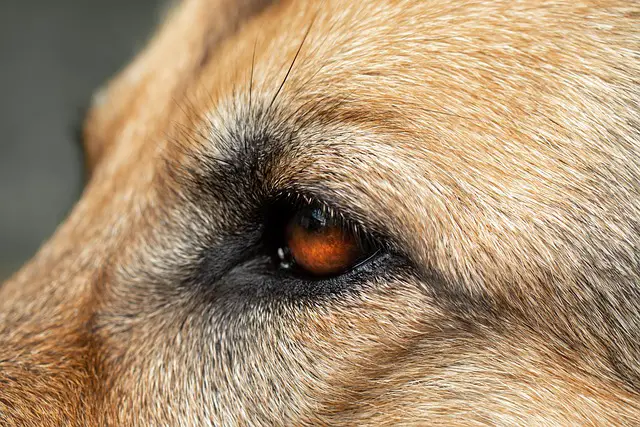We’ve put together a list of potential German Shepherd eye problems your dog or puppy may encounter over their lifetime
The list contains some eye problems that are thought to be genetic diseases in the German Shepherd breed, and some problems that might be common to all dog breeds.
We’ve included symptoms/signs of each eye problem, as well as other useful information.
Let’s take a closer look!
(NOTE: this is a general information guide only, and is not professional advice, or a substitute for professional advice. A qualified vet or animal expert is the only person qualified to give you expert advice in regards to your pet/s)
7 Potential German Shepherd Eye Problems Your Dog Might Experience
A Word Of Caution
If you suspect your dog’s health is at risk, or an eye problem is serious, see a vet for an expert opinion on how to treat it.
1. Pannus (also known as Chronic Superficial Keratitis)
What is Pannus?
Pannus is an eye condition where blood vessels and scar tissue invade the cornea. It can lead to blindness
Symptoms Of Pannus?
Your GSD may display some of these symptoms:
Red, blood-shot eyes
Excessive tearing and weeping
A grayish-pink film covering the eyes
Coloring of the cornea, usually dark brown or black
Opaque cloudiness of the eye
Thickening and loss of color of the third eyelids
Causes Of Pannus?
It is unknown WHAT exactly causes pannus, but it is thought to be a genetic autoimmune disease in the GSD breed (although it does affect other dog breeds too such as Huskies and Greyhounds).
There is also some evidence to suggest Pannus worsens with exposure to UV light, high altitudes and pollutants in the air.
Pannus Treatment
You’ll want to see an animal eye specialist.
On going treatment is usually required, as the disease may not be able to be cured.
2. Cataracts
What Are Cataracts?
Cataracts are opaque spots on the lens of the eye that may cause blurriness or a loss of vision.
Symptoms Of Cataracts
If the eye appears cloudy or bluish-grey, this can be a sign of cataracts.
Causes Of Cataracts?
Most often cataracts are a result of a hereditary disease, but can also develop with age or with eye trauma.
Cataract Treatment
A vet may decide to surgery is the best option to remove a cataract from your dog’s eye.
3. Cherry Eye
What Is Cherry Eye?
Dogs have a third eyelid you can see in the corner of their eye which is responsible for protection of the eye and producing tears.
Cherry eye is when the gland in this third eyelid becomes prolapsed – swollen, enlarged and inflamed.
Symptoms Of Cherry Eye
You will be able to see the enlarged gland protruding from the edge of the third eyelid.
It looks like a little red lump (like a cherry).
Causes of Cherry Eye
Cherry eye is caused by a congenital weakness in the eye’s attachment to the eye – which experts don’t know if is a hereditary disease or not.
Cherry Eye Treatments
A vet will usually decide to either operate and replace or remove the gland, or prescribe anti inflammatory medication.
Other Eye Conditions Your German Shepherd May Experience
Other eye problems might include:
4. corneal dystrophy,
5. retinal dysplasia,
6. lens luxation,
7. and sometimes progressive retinal atrophy.
Other German Shepherd Eye Problems Resources
Friendly Disclaimer
TheDailyShep.com are not veterinarians, or animal professionals/experts. Information provided is for informational purposes only – it is not a substitute for professional or qualified advice.
The information is based on either our own thorough research, and/or own experiences, as a means of free speech.
By consuming this information, you accept that TheDailyShep.com do not have client or patient relationship with you, and TheDailyShep.com are not advising you to act on anything you read.
You should always consult your own veterinarian, animal expert, or health care professional and follow their advice before making decisions on all matters.
You can find our full set of disclaimers and T & C’s in the footer of this site.
Enjoy your reading, and thank you for being here
','' ); } ?>